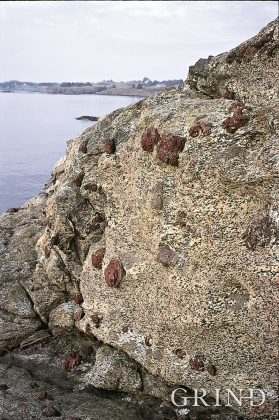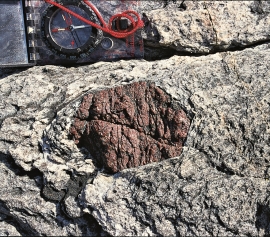Published: 07.08.2015 | Author: Haakon Fossen
GARNETS
On Vågenes, on one of the prominences out toward Eitrevågen, one finds garnets in anorthosite. The garnets are both older, and not least bigger, than average.
Garnets are a type of mineral that occurs many places in Hordaland, especially in mica schists. The majority of these garnet crystals are from a few millimetres to a centimetre in size. These garnets grew when the temperature increased during the Caledonian collision between Greenland and Scandinavia.
On Vågenes, the red-brown garnets can be " as big as a child's head", as one geologist is supposed to have said - and they were formed during an earlier collision. It was the Svekonorvegiske mountain-folding event about a billion years ago that created the good conditions for the growth of garnets in this area: the right type of bedrock, suitable temperature and rich concentrations of mineral-bearing fluids with the right chemical composition. Each garnet has probably used several million years to grow to full size. Later, they have become cracked,, most likely in connection with the Caledonian mountain chain folding about 400 million years ago. The fracturing has meant that the garnets are far from gem-quality. But, they are pretty to look at, and there are scarcely any bigger ones in all of Hordaland. Some places the garnets have weathered away and left only hollows in the bedrock.
In addition to jewellery, garnets are used as a polishing and grinding agent, i.e. in the production of sandpaper. Artificial garnets are also used in the laser- and computer industry.




